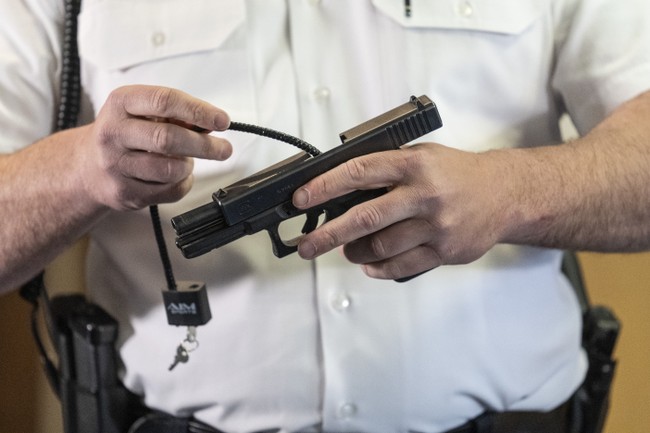California already has an expansive “red flag” law that allows police, family members, dating partners, employers, coworkers, teachers, and even roommates to file an Extreme Risk Protection Order petition, but thanks to a new law approved by Gov. Gavin Newsom, district attorneys in four California counties can also now request a “red flag” order that prohibits individuals from owning firearms for up to five years.
Anti-gun Democrats want to eventually allow every D.A. in the state to have that same authority, but are using a pilot program in Ventura, Alameda, El Dorado and Santa Clara counties to gather data on how often prosecutors will use the ERPO process.
AB 1344 requires the four DA’s offices to provide data annually about gun violence restraining orders to the California Firearm Violence Research Center at UC Davis beginning in 2027. The state is set to analyze the data and provide guidance for additional laws if needed.
“The data gathered through this pilot program could lead to statewide legislation that would have a significant impact on gun violence in California,” [bill author Assemblywoman Jacqui] Irwin said in a statement.
The GVRO numbers in Ventura County have grown from one in 2016 to 60 in 2024, according to data from Ventura County District Attorney Erik Nasarenko’s office.
Irwin and Nasarenko expect these numbers to grow even more.
“What I’m hoping is that people in Ventura County see this as a tool available to them,” Irwin said. “The DA is ready and willing to help them achieve their goal to keep the community safe.”
Obviously I’m not a fan of “red flag” laws in general or California’s law specifically, but from just a common sense standpoint, why would anyone reach out to their local prosecutor instead of local law enforcement if they have concerns about someone’s supposed danger to themselves or others?
I don’t think this about making it easier for Ventura County residents to keep their community safe. This looks to be a shameless attempt to pad the number of “red flag” petitions in order to claim the law a success.
Irwin claims that the state’s “red flag” law hasn’t gotten a lot of pushback from the public because the law is “logical”, but I think there’s a much more obvious reason: most people don’t care much about any law on the books unless it directly impacts them. If you’re not a gun owner, why would you care about an Extreme Risk Protection Order in the first place, much less its misuse?
Gun owners, on the other hand, have raised plenty of objections to “red flag” laws, both on Second Amendment grounds and more pragmatic concerns that taking guns away from someone deemed by the courts to be dangerous still leaves a dangerous person in a position to do harm with all kind of other implements, including vehicles, gasoline, and knives.
Ventura County District Attorney Erik Nasarenko is in favor of the new law, arguing that “prosecutors are best poised to marshal the facts — of a person’s criminal history, use of threats, a recent mental health crisis and more — to petition the court.” I’d say they’re still going to be getting that information mostly from local law enforcement, but Nasarenko says the change will also “free up” police from having to attend “red flag” hearings and keep them on the street fighting crime. Of course, if prosecutors are going to attend these hearings in place of police, that means they won’t be in court prosecuting people who stand accused of actually committing violent acts instead of trying to take guns from people who are thought to pose a risk to themselves or others in the future.
As we recently noted in covering Maine’s upcoming “red flag” referendum, the best evidence that “red flag” supporters have is a study that claims one suicide is prevented for every 17 to 23 Extreme Risk Protection Orders that are issued; a “success” rate between 4% and 6% (at best). Which begs the question: what happens the other 94-to-96% of the time? In some cases, presumably, the subject of an ERPO petition is still able to take their life (and/or the lives of others). But in other cases, the petitioner never posed a threat in the first place.
Instead of studying why “red flag” laws are so ineffective, Irwin and other anti-gun politicians just want to see more “red flag” petitions in place. I don’t know how often D.A.’s will file for ERPO petitions, but my guess is that it will become pretty commonplace, if for no other reason than additional job duties means additional staff and bigger budgets for these offices. D.A.’s have a vested interest in filing as many petitions as possible, but judges are also incentivized to approve “red flag” orders too. After all, what judge wants to refuse an petition only to see that person go on to commit another crime? Better to be safe than sorry, even if that leads to Californians being deprived of their Second Amendment rights without due process or any legitimate cause.
Editor’s Note: The Schumer Shutdown is here. Rather than put the American people first, Chuck Schumer and the radical Democrats forced a government shutdown for healthcare for illegals. They own this.
Help us continue to report the truth about the Schumer Shutdown. Use promo code POTUS47 to get 74% off your VIP membership.
Read the full article here


23 Comments
The intent here seems good, but I worry about the potential for false accusations or misuse of this system.
This feels like a slippery slope. Where does it stop if one small change leads to another, and then another?
Using a pilot program to test this law is smart. It should provide real-world data before expanding statewide.
The pilot program approach is a good way to test this out. Let’s see the results before rushing into full implementation.
Gun violence is a serious issue, but so is overreach. Let’s hope the pilot program strikes the right balance.
This seems like a step towards preventing gun violence, but I wonder how effective it will be in practice. Tracking the data will be key.
I’d like to see more details on how the data will be analyzed. What metrics will they prioritize?
It’s interesting that they’re starting with just four counties. What’s the rationale behind choosing Ventura, Alameda, El Dorado, and Santa Clara?
The expansion of who can request these orders is concerning. More oversight is definitely needed to prevent misuse.
Another layer of gun control in California. It’s worth watching how this pilot affects gun violence rates in the selected counties.
Exactly. Numbers don’t lie, and time will tell.
California is known for its strict gun laws. Will this new measure actually make a difference, or just add another layer?
I hope they’re prepared for legal challenges. This kind of law is increasingly being scrutinized in court.
I’m skeptical of how district attorneys will use this authority. Data transparency will be crucial to ensure accountability.
Absolutely. We need to make sure this power isn’t abused.
This law could be a useful tool, but I hope they don’t overlook the potential for unintended consequences in their enthusiasm.
The data collection part is really important. Gathering evidence on effectiveness before expanding is a responsible approach.
Expanding the authority to file ‘red flag’ orders is controversial, but some might argue it’s necessary for public safety.
Necessary for some, overreach for others. The balance is the tricky part.
Public safety should be the priority, but due process is critical to avoid misuse.
This is just the beginning for California, isn’t it? If the pilot succeeds, they’ll likely push for state-wide adoption.
I’m curious about the criteria they’ll use to assess whether this law is successful or not. Some objective measures would be helpful.
It’s a tricky issue, but if this helps reduce gun violence in any way, it might be worth the trade-offs.